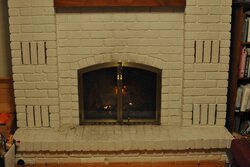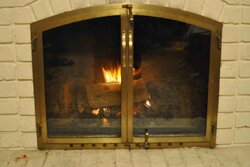Hello group
I have a fireplace, and am wondering what you think is
its efficiency and if there is anything I can do to improve it.
It has a glass front door that is pretty tight fitting.
I could seal little cracks between the bricks and the metal frame.
There is already something there.
Inside is metal. I put some fire bricks around the back wall and sides.
I read somewhere that this could reduce the size of the burning space which may be too big.
My impression was that this made it run better.
The inner walls of the fireplace are metal.
I have damper. Everything is fine when it is open but if I close it down, smoke comes into the
room.
Notice the brickwork has these 4 vents. These are pretty nice. once warm, because of convection,
the air flows through. The bottom is the intake and the top is the exhaust. I figure it runs across the fire area
(above it?). There is not fan on the ducts. I was thinking about putting some in.
Thanks
I have a fireplace, and am wondering what you think is
its efficiency and if there is anything I can do to improve it.
It has a glass front door that is pretty tight fitting.
I could seal little cracks between the bricks and the metal frame.
There is already something there.
Inside is metal. I put some fire bricks around the back wall and sides.
I read somewhere that this could reduce the size of the burning space which may be too big.
My impression was that this made it run better.
The inner walls of the fireplace are metal.
I have damper. Everything is fine when it is open but if I close it down, smoke comes into the
room.
Notice the brickwork has these 4 vents. These are pretty nice. once warm, because of convection,
the air flows through. The bottom is the intake and the top is the exhaust. I figure it runs across the fire area
(above it?). There is not fan on the ducts. I was thinking about putting some in.
Thanks



